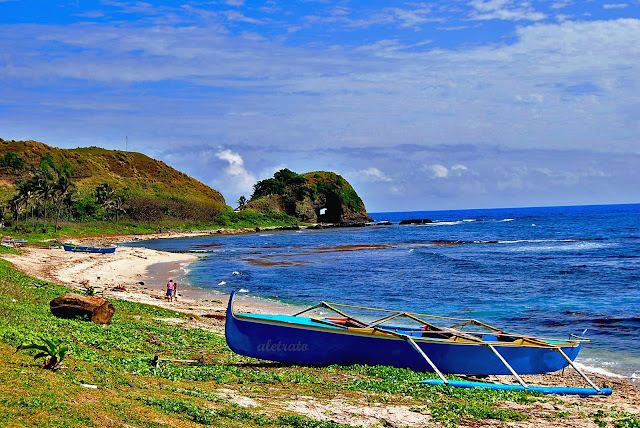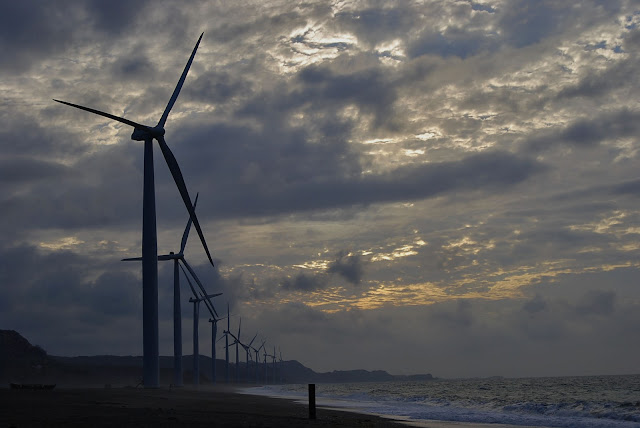It's getting dark and we have to find a place to stay in Pagudpud (Pa-good-pood), we haven't made reservations on any resorts, homestays or hotels, so we have to hurry before I get hungry!
The town of Pagudpud was once a barangay of Bangui town. It only became
an independent municipality in 1959 when a group of political leaders
petitioned to separate Pagudpud from Bangui was granted. My anxiousness
was comforted as I saw the white arch with that bold green letters
"PAGUDPUD" on it and I grinned with excitement! The road going to Pagudpud has a firm surface, you will pass by greenwoods and vegetations on most front yards of the locals, which shows how diligent and resourceful Ilocanos are. Rice farming and fishing are their main source of income. The place is a favorite tourist destination during summer for its vast and magnificent gold sand beaches. There are a number of beach resorts on the coast, Saud Beach Resort and Pannzian Beach Resort to name a few are the most popular. The municipality also encourages homestay for visitors who would want to learn the Ilocano lifestyle.

Travelling for three days was exhausting, and because we don't have a place to stay, finding for it makes it more tiring. We did some house hopping in the town proper, there were many houses to choose from but they didn't really suits our liking. Until we came across a pretty peach house while on our way to leave the town and read the small signage hanging on its garage saying "Josie's Homestay"! We stopped and looked for the owner and met "Manang Josie". She let us in her house and gave us a fair rent for the two rooms we'll occupy. Manang Josie's house is very spacious and can accommodate a number of tourists. The round dining table is big enough for a family of twelve. The kitchen area is complete with utensils and the landscaped garden is surrounded with colorful hibiscus. Picnic huts are available in case you want to dine al fresco. Tents are also allowed in the commodious garden, just ask the owner and she'll be willing to lend and set it up for you.

Time is running and we still have many places to go so we have to step on the gas! Not far from Manang Josie's house is the beautiful place of Balaoi, where more treasures can be found! The enchanting Kaibigan Falls which is just a 30-minute trek from the main road is like a walk in the park. Mang Joe our tour guide told stories about the place, tales about how it got its name, the culture of the people and how they protect the environment. It is pretty obvious how patient they are in maintaining its grace.
Is there a sight more heartwarming being greeted by a pair of ducks dabbling on the stream?
And walk along the fertile trails of rice farms, with the clouds and the forests touching each other? The smell of fresh air and the vivid foliage which we passed by gives an impression that a natural wonder awaits!
The flow of water in the brook plays a melody while it surge from one rock to another and while being shaded by abundant greenery. I didn't notice the time spent on walking, when I suddenly heard a loud gush of water!
And that's it! The white flow of water looks so immaculate from where I was standing, I hurriedly went nearer to see how pure it is, I took a dip and the water was so cold! Kabigan derived from the word kaibigan (friend) has its own legend to tell. The falls is approximately 87 feet with a concave basin underneath to hold the water, and for the tourists to enjoy. It is sad that we have to leave this natural garden at once, I took several pictures of it for me to keep and cherish.

If your imagination is very creative, at a distance... you'll think that the Bantay Abot Cave is a great whale docked on the shore, isn't it? No? Well for me, it is! Sometimes it amuses me to visualize the physical world into something entertaining, my thought can give them more life and character. The Bantay Abot cave is actually a big rock with a hole in the middle, it was formed due to the powerful waves which smashes the hill, and it is situated in Balaoi, you'll pass by it on your way to Maira-Ira Point which is just a few meters away from Bantay Abot Cave.
After spending sometime in taking pictures in Bantay Abot Cave, we went to Maira-Ira Point popularly known as Blue Lagoon. I was very curious at first why it is called Blue Lagoon, the first thing which came to my mind was Brooke Shields who starred in the famous film with the same name, the only difference is that this place is prettier than her.
There are a number of beach resorts in the area which usually offers homestay, so tourists can enjoy their vacation. There are also cavanas along the beach which can be hired for a fair amount if you're only planning to stay the whole day. And since we'd like to relish the beauty of the place we chose to pitch a tent, play frisbee on the shore, frolic in the sea, watch the splashes of waves, whistle while the clouds pass by, and quench our thirst with ice cold beer.
How can I resist the clear water of Blue Lagoon with its fine white sands which didn't even hurt my feet? The inviting waves which comes and go as if calling me to embrace the cold water?
Hitting the road again, after passing time in Blue Lagoon, we found ourselves in a concrete winding long bridge along the coast of Pasaleng Bay, the Patapat Viaduct. This bridge connects the Maharlika Highway from Laoag, Ilocos Norte to the Cagayan Valley Region.
This viaduct was constructed to solve the problem
of landslides in the area which have caused so many vehicular accidents in the past. You know, you can do a lot of things in a road while it is not busy, you can do planking, you can take jump shot pictures as much as you can, sit in the middle of the road, scream, or just stand and enjoy the spectacular view of the seascape. Just make sure no vehicles are coming.
You wanna go here? Hurry don't be too late!
The Patapat viaduct is about 16+ kilometers from
Pagudpud, Ilocos Norte.
From Pagudpud, simply head northeast towards Cagayan. The landscape changes if you continue along the northern road leading to Claveria, but we were not able to go on due to time constraints, we have to go back to Ilocos and go home. But my journey doesn't end here, there will be plenty of time soon.
The province of Ilocos Norte is rich in history as well as nature sites of great beauty, and I admire the Ilocanos for their dedication in preserving its treasures that until now they are still in its priceless glory.
Thank you for reading.





















